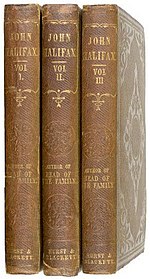| This article needs additional citations for verification. Please help improve this article by adding citations to reliable sources. Unsourced material may be challenged and removed. Find sources: "John Halifax, Gentleman" – news · newspapers · books · scholar · JSTOR (April 2019) (Learn how and when to remove this message) |
 First editions First editions | |
| Author | Dinah Craik |
|---|---|
| Language | English |
| Publisher | Hurst and Blackett |
| Publication date | 1856 |
| Publication place | Great Britain |
| Media type | |
John Halifax, Gentleman is a novel by Dinah Craik, first published in 1856. Through hard work, the protagonist becomes a successful industrialist. The novel is set in the context of Britain's Industrial Revolution.
The book sold well in the 19th century. In the 20th century it was adapted for film and television.
Location
Dinah Craik grew up in an industrial conurbation, the Potteries district of Staffordshire. However, the plot of the novel revolves around Tewkesbury in Gloucestershire, an town which she visited but never lived in. While Tewkesbury was not heavily industrialised, there are mills such as Abbey Mill, dated 1793, which supposedly features in the book along with other prominent buildings.
A memorial to Dinah Craik was erected in Tewkesbury Abbey.
A photographic postcard, probably from the early 20th century, depicts Dunkirk Mills, Inchbrook, near Nailsworth and Stroud, Gloucestershire, stating it was the "original Mills of 'John Halifax Gentleman'".
A discussion on a Stroud Fakebook page suggests that Enderley and the cottage were modelled on an area near Avening.
Plot summary
The story is narrated by Phineas, a friend of the central character. John Halifax is an orphan, determined to make his way in the world through honest hard work. He is taken in by a tanner, Abel Fletcher, who is a Quaker, and thus meets Phineas, who is Abel's son. John eventually achieves success in business and love, and becomes a wealthy man.
Editions
The novel was first published by Hurst and Blackett. It has been published in dozens of editions and translated into various languages.
An illustrated edition was published by J. M. Dent & Co. in 1898, with twelve colour plates by three artists: W. C. (Cubitt) Cooke. L. M. (Laura) Fisher and F. C. (Frederick Colin) Tilney.
Adaptations
The novel has been adapted several times. A 1915 silent film John Halifax, Gentleman was directed by George Pearson. In 1938 a film version John Halifax was made.
The novel was adapted for BBC Radio 4 in 1970. In 1974 a BBC series John Halifax, Gentleman was made starring Robert Coleby.
In popular culture
The books appears to have been awarded frequently as a prize by Sunday Schools.
The book is mentioned in Agatha Christie's 1935 novel Why Didn't They Ask Evans?.
The book is mentioned in the first Elinor Brent-Dyer’s Chalet School series, “The School at the Chalet”, as being read three times consecutively by central character, Jo Bettany.
References
- Bassett, Troy J. "Publisher: Hurst and Blackett in 1856." At the Circulating Library: A Database of Victorian Fiction, 1837—1901, 31 October 2024, http://www.victorianresearch.org/atcl/show_publisher_titles.php?pid=7&year=1856. Accessed 25 November 2024.
- ^ "Mrs Craik - Potteries author". Retrieved 25 November 2024.
- Historic England. "Details from listed building database (1201210)". National Heritage List for England.
- "Design for a memorial to Mrs. Craik, Tewkesbury, c. 1889". Retrieved 25 November 2024.
- Results 1 to 20 of 37 for John Halifax, Gentleman Retrieved 30/12/2021
- Chapter 7.
- Chapter 11.
External links
- John Halifax, Gentleman at Project Gutenberg
 John Halifax, Gentleman public domain audiobook at LibriVox
John Halifax, Gentleman public domain audiobook at LibriVox- John Halifax, Gentleman at IMDb

This article about an 1850s novel is a stub. You can help Misplaced Pages by expanding it. See guidelines for writing about novels. Further suggestions might be found on the article's talk page. |